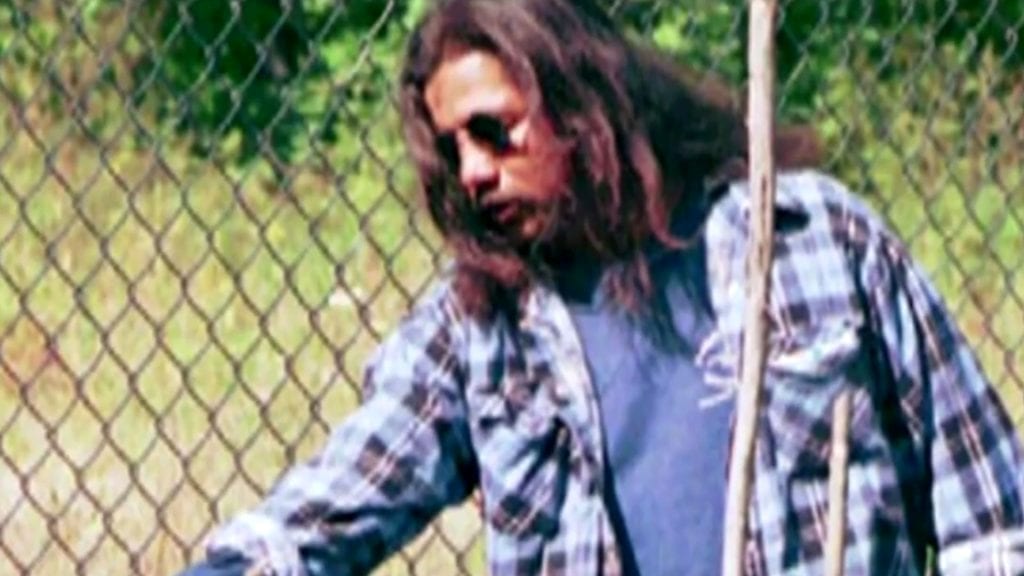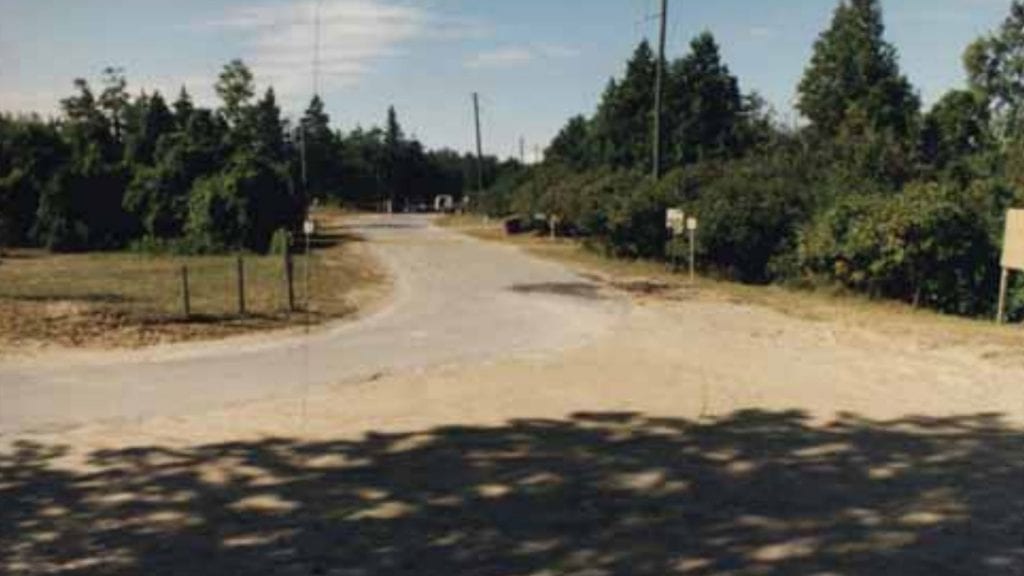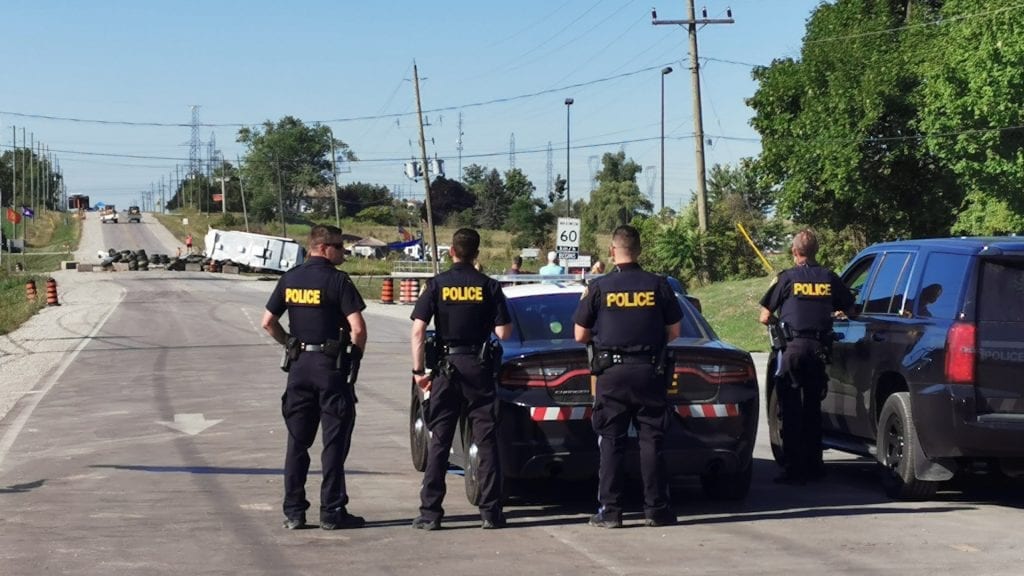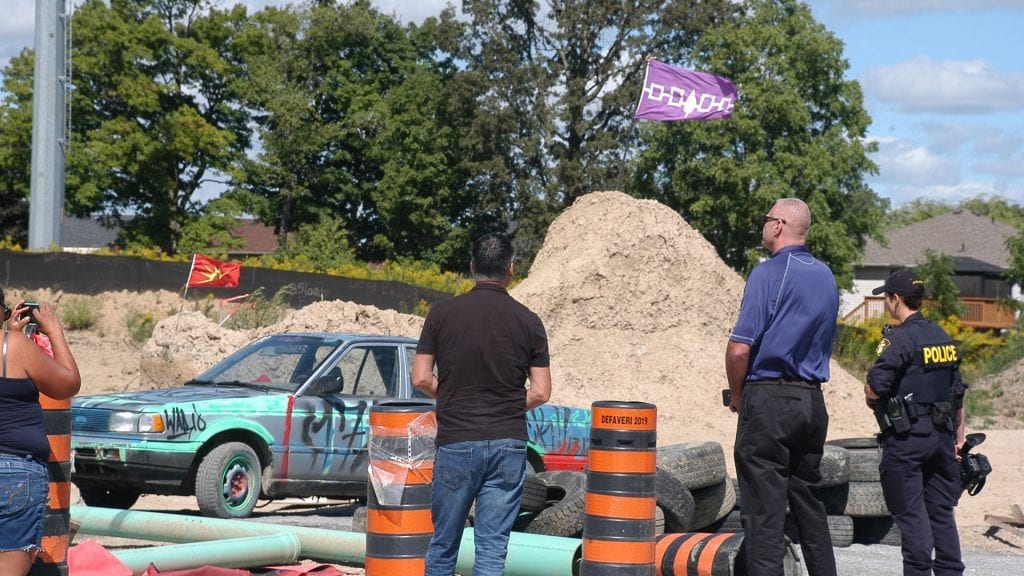
Dudley George was killed by a member of the Ontario Provincial Police on Sept. 6, 1995.
Twenty-five years ago, heavily-armed Ontario Provincial Police (OPP) officers marched shoulder-to-shoulder in utter darkness toward Ipperwash Provincial Park, which two days earlier members of an Anishinaabe First Nation in southwestern Ontario reclaimed as part of the former Stoney Point reserve.
Park occupants heard the feet stomping in the blackness as the tactics and rescue unit (TRU) led the way armed with night-vision goggles and sniper rifles. Choppers and police watercraft spent preceding days surveilling.
Thirty-two crowd management unit (CMU) officers followed in tight box formation wearing helmets with visors down, shields, batons and firearms. They were followed by an eight-officer arrest team, two canine units and two prisoner vans.
“Hasty decisions with unfortunate consequences,” wrote Commissioner Sydney Linden, as he reviewed the mistakes that led to this scene, in his final report of the Ipperwash Inquiry.
“Tragic consequences followed within minutes.”
In the ensuing violent clash, police beat a man nearly to death, shot at a bus driven by a 16-year-old, and killed unarmed Anishinaabe man Anthony “Dudley” George with sniper fire to the chest.
In 1997 TRU Acting Sgt. Ken Deane was convicted of criminal negligence causing death. He died before he could testify in the inquiry.
Linden determined that the OPP had deployed these officers based on erroneous and inaccurate intelligence. Police did not ask Anishinaabe police for help, even though the Kettle Point detachment was only a few kilometres away.
Nor did police give the people in the park any indication of what was going on. The objective was not to raid the park and arrest those in it, Linden concluded, but to make sure the people didn’t spill onto the sandy parking lot just outside of the park boundaries.
Instead, officers marched up to the park gates and traded insults with First Nations people on the other side.
Violence ensued.
Twenty-five years later, the OPP and the province frequently point to Linden’s findings as they struggle with a different occupation – the takeover of the McKenzie Meadows housing development construction site in Caledonia, where people from nearby Six Nations of the Grand River and their supporters established a reclamation camp in July.
“Our government remains focused on the recommendations of the Ipperwash Inquiry and improving relationships with Indigenous peoples to ensure tragedies, like the one at Ipperwash Park, never happen again,” said Ontario Indigenous Affairs Minister Greg Rickford in a statement on Sunday.
But even as they’ve corrected some critical errors, the OPP and Ontario come close to repeating others.
Distinct Aspects of Indigenous Occupations
Linden faulted police in 1995 for treating the Ipperwash occupation like a sports riot.
He concluded that the OPP officer commanding the CMU took the wrong approach because he didn’t understand how unique aspects of Indigenous culture and history contribute to occupations and blockades.
“He did not understand the Aboriginal people’s connection to the land and the significance of their assertion that burial grounds, sacred sites, were in the park,” wrote Linden.

“Many of the occupiers were related by blood – brothers, sisters, cousins, uncles. Family and friends participated in this occupation, not strangers in a soccer or hockey crowd.”
This unity of purpose wasn’t something police counted on. When police confronted the park occupants, they didn’t run, they fought back.
Something similar happened in Caledonia when police arrested nine people in a raid on the McKenzie Meadows camp on Aug. 5.
Six Nations community members reacted quickly by setting tires, train tracks and construction equipment ablaze.
They then erected a large barricade of concrete, vehicles and tires just outside the gates of the former Douglas Creek Estates, now known as Kanonhstaton, where conflict erupted over construction of a different subdivision in 2006.
Still on Kanonhstaton, community members erected another camp, which remains up, in solidarity with the McKenzie Meadows occupiers. People flooded the Meadows camp, dubbed 1492 Land Back Lane, again that evening. It thrives a month later.
As provincial government lawyer Christopher Diana, summarizing this often dramatic and tense escalation put it, “Violence ensued.”
Police did not expect or have resources to handle this wave of solidarity actions, Diana explained.
“The OPP doesn’t have the ability to hold land. I mean that’s not why the police were formed,” he told an Ontario Superior Court judge in Brampton on Aug. 25. “They can’t leave a whole unit just to preserve McKenzie Meadows or anywhere else. They’re simply not resourced to hold property.”
Police fired a single rubber bullet, they say, after peopled hurled rocks at them. They didn’t count on the blowback, and things escalated violently and quickly.
As 1492 Land Back Lane Spokesperson Skyler Williams told APTN News on Aug. 20, two days before the community dismantled the blockade, “Our intention has never been to hinder anyone’s use of the roads. That was done as a reaction to police violence.”
Police had to divert resources to deal with numerous blockades and fires, and ultimately they couldn’t hold the Meadows. They miscalculated.
Colour of Right
Speaking on behalf of the province’s top cop, Diana referenced the findings of the Ipperwash report multiple times as he justified the OPP’s apparent hesitation to raid the land reclamation camp a second time.
“There could be a reaction or response as there was earlier to enforcement action. And there’s a long history in this area of tension and volatility, and impacts may extend beyond this area. We’ve seen other places in the province that have seen volatility arise,” said the lawyer.
“When you bring an injunction forward it gives other individuals an opportunity to have their point to be heard, to have their colour of right argued or articulated in court,” he added.
Linden mentioned the legal concept of colour of right multiple times in his findings.
“Colour of right,” he said, “can afford a defence to people who might otherwise be trespassing but have an honest belief that they are entitled to property.”
Ipperwash occupants had a strong colour of right defence. Linden faulted officials for not giving it due weight.
The lands known as Ipperwash Provincial Park and CFB Ipperwash in 1995 were once both part of the Stoney Point reserve.
The parcel that became the park was sold to a private owner after Indian Agents obtained a since-disputed surrender of Lake Huron waterfront in 1928, while the federal government expropriated the rest of the reserve in 1942 under the War Measures Act – promising to give it back afterward.
The occupiers on McKenzie Meadows have articulated their colour of right – the reason why they believe they have a right to be on that land – several times.
“We have the deed for this land, and the onus is on you guys to show us that you obtained this land legally and fairly,” spokesperson Skyler Williams told APTN on Aug. 16. “To date they’ve not produced anything.”
The Haudenosaunee Confederacy Chiefs Council threw their support behind this colour of right defence as well. On Aug. 15 the traditional governing authority called the McKenzie Road development “unlawful”.
While those who support the occupation say the Haudenosaunee never ceded the parcel, the property developer disagrees.
In court, Foxgate Developments submitted a pre-Confederation 1853 Crown land grant that describes the sale of Six Nations reserve land to a private citizen. Thomas Nicholls purchased the land after he contracted the sale with the superintendent of Indian Affairs.
Foxgate’s lawyers said that land, on which McKenzie Meadows is supposed to be built, has been possessed by third-parties ever since. A court affidavit maintains the company was not aware of any objection to the project by any First Nations group.
Six Nations of the Grand River elected council, which agreed to “publicly support” the development, explained on July 24 that the band would not be able to have the McKenzie Road site returned from a third-party due to “the passage of time.”
But the band, the elected council said, may have a legitimate claim against Ontario and Canada. A 1995 suit “asking the Crown to account as a trustee for all the land and money that were taken” remains before the courts.
Foxgate, as it pursued extension of its injunction, submitted this July 24 “community update” in court as evidence the company is the lawful owner of the disputed land.
Williams and the occupiers will have a chance on Oct. 9 to argue their colour of right in court and convince a judge to rescind the injunction ordering them off the site, unless police enforce the order before then.
Indigenous Critical Incidents Framework
Diana emphasized the OPP’s reliance on its Framework for Police Preparedness for Indigenous Critical Incidents, essentially a policy directive guiding incident commanders as they confront Indigenous occupations or blockades.
“This document, the framework, came out of the Ipperwash inquiry and was seen as a ‘best practice’ by Commissioner Linden in the course of that inquiry,” he said. “It’s been used ever since to help inform and guide OPP response.”
Both Ontario Solicitor General Sylvia Jones – the person in charge of provincial public safety policy – and OPP Commissioner Thomas Carrique also pointed to this document.
“The OPP is guided by A Framework for Police Preparedness for Aboriginal Critical Incidents, which is identified as a best-practice out of the 2007 Ipperwash Inquiry,” said Jones’s press secretary Stephen Warner in an email.

“The Framework guides the police response to both Indigenous and non-Indigenous issue-related conflicts.”
Warner did not respond to further questions or an interview request from APTN.
Flanked by Premier Doug Ford on Aug. 20, as the province announced the addition of 200 new peace officers, Carrique said almost the exact same thing.
“The OPP work under a court endorsed framework for police preparedness for response to Indigenous incidents and we are working within the parametres of the injunction,” he said.
“Our primary responsibility is to preserve peace and maintain public safety, and that involves having negotiations, mediation and ongoing dialogue to find sustainable solutions.”
APTN has requested several on-camera interviews with an OPP spokesperson to seek more information, but none have been granted.
“The OPP has no role to play in land dispute issues and is not in a position to resolve them,” said spokesperson Cst. Rodney LeClair in an email on Aug. 25.
Political Pressure
Linden explained that the solicitor general “is the guardian line” between police and politicians “to ensure there is neither the fact nor the appearance of political interference with the police.”
Ford has stressed on multiple occasions that he will not, and does not, direct police in operational matters. He has not taken a position publicly on the complex underlying issues of the centuries-old Grand River land dispute.
But he has said those who break Ontario’s laws and clash with police will suffer consequences.
“There’s one country, one law,” he said on Aug. 6, the day after the raid, fires and barricades. “I don’t care where you come from, what your race, creed, colour, whatever – we have one country, one rule, and that is it.”
Ford said he believes dialogue is the best way forward and said he spoke with elected Chief Mark Hill.
But, as he stood with Carrique, Ford said he will take a “zero tolerance” approach if violence ensues.
“I have zero tolerance. And I don’t care who you are,” he said. “You start attacking our police, I’ll come out swinging. Simple as that.”
The following day APTN asked the premier if he stood by his comments. He said again he believes in dialogue and collaboration first, but he doubled-down on his firm stance.

“I’m dead serious – anyone who wants to come after our police officers, and I’m not saying just the Indigenous community or anyone else – they want to throw rocks at our police officers, they want to throw outhouses over a bridge and almost kill someone, then yes absolutely.”
Mike Harris was the freshly-elected Ontario Conservative premier during the Ipperwash tragedy. He governed until 2002, and the Tories held power for one more year.
From 2003 to Ford’s election in 2018, the Liberals sat in Queen’s Park. This means Ford is the first Tory premier since Harris to deal with major Indigenous blockades and occupations.
The province already has one incident in the rear-view mirror – the February Tyendinaga rail stoppage in which Mohawk demonstrators and their supporters halted trains in the country’s busiest rail corridor. They set up camp to support Wet’suwet’en hereditary chiefs who were at odds with B.C. and the RCMP over a pipeline slated to be built on unceded territory.
In the 2006 Caledonia dispute over a different housing development, Dalton McGuinty’s Liberals purchased the Douglas Creek Estates from the developer after Six Nations people occupied the site and stopped work.
It remains in the province’s name, held in trust until the parties reach a solution. Now known as Kanonhstaton, the site is almost right next to McKenzie Meadows.
Linden concluded that Ontario did not cross the line and interfere with police.
But Harris made his position crystal clear when he said, on this day 25 years ago, “I want the f—ing Indians out of the park.”
After examining conflicting accounts, Linden concluded that the premier made this statement that, in the commissioner’s view, was “racist.”
While it didn’t constitute political interference, the OPP Incident Commander John Carson knew the premier wanted the occupation over quick.
Linden also remarked that Harris’s “one justice for all” policy, in which First Nations would receive no differential treatment, created friction with police.
Pressure from Local Politicians
APTN asked Warner if the solicitor general stands by Ford’s commitment to “come out swinging” if things escalate, but did not receive a response.
When court sheriff enforcement officers showed up at McKenzie Road to read an injunction on Sept. 4, they were met with a small barricade – perhaps an indication blockades could go up and things escalate once again if police raid.
While the province has indicated they do not and will not direct police, the mayor of Haldimand County showed less restraint when it comes to public comment on operational matters.
In an Aug. 7 statement, Ken Hewitt said he would “push for the OPP to apply the injunctions on those breaking the judge’s orders and I will look to our judicial system to apply the law on those that so just deserve it.”
He reiterated the sentiment again on Aug. 19.
“We fully expect that the OPP will act on these injunctions should those so choose to continue to defy the wishes of the majority on Six Nations and Caledonia.”
After Hewitt speculated on when police might enforce the injunction against people at the camp, APTN asked if police were sharing operational information with him.
LeClair confirmed that Hewitt has been in contact with incident command staff.
“I don’t know where Mayor Hewitt obtained that information,” he replied. “Discussions between our command staff and Mayor Hewitt are ongoing.”
After LeClair said he wasn’t available for an interview, APTN followed up on Aug. 24 and asked him if police were sharing operational information concerning Caledonia with politicians of any sort. APTN also asked LeClair to confirm with whom Hewitt was speaking.
In a four-line email reply, he didn’t answer the questions directly.
On the same day, and almost at the same time, as the injunction was served, Hewitt reiterated he corresponded frequently with police.
“I have been in contact with them [OPP] daily and the process that they are deploying today to clear the protestors off the site is one that I can support.”
This was after police upped the pressure and started arresting a rising number of people off-site.
As of Aug. 24, the number of people arrested stood at 10. On Sept. 2 and 3, the number rose to 17.
In an Aug. 19 phone interview, APTN asked the mayor if, having pushed for enforcement, he was concerned about another escalation.
“I would much rather see the members of Six Nations and those on the site come to a solution that is much more manageable in not having a confrontation with police or anybody for that matter,” said Hewitt.
“But at the end of the day, we have to get our roads open, we have to allow for commerce to continue, we have to support our developers and our builders and that’s where we’re at.”
A request for another interview sent on Aug. 24 was not returned.
In his report, Linden examined the interactions that OPP incident command had with the mayor of a nearby municipality in 1995.
Fred Thomas of Bosanquet met with Incident Commander Carson at 8:15 a.m. on Sept. 6, 1995 at the command centre where the mayor said his community felt “terrorized” by the Ipperwash occupation.
Linden faulted police for this too, which contributed to a significant recommendation.
“Such meetings in the command post can distract Incident Commanders from their jobs. They also create the risk of actual or perceived improper political direction of the police,” wrote the commissioner.
“It is my recommendation that the OPP appoint a buffer, a community liaison officer, to meet with local politicians and community representatives.”
Provincial Liaison Team
Coming out of the inquiry, the government created the Aboriginal Relations Team (ART), now known as the Provincial Liaison Team (PLT).
It remains unclear if Hewitt communicated with people making operational decisions at the command centre or if he corresponded with liaisons who remain at arms-length from enforcement planning.
Despite repeated inquiries, LeClair would not confirm if these liaisons have been the people whom Hewitt, in his own words, “push[ed] for the OPP to apply the injunctions.”
Diana explained in court that the PLT is central to the OPP’s response to Indigenous occupations or blockades.
“These are a group of officers dedicated to outreach, to understanding the issues, both from the developer’s perspective and from the protesters perspective to try to effect, where possible, peaceful resolutions,” said Diana.
“PLT has been on the front-lines of dealing with injunctions for many years now, and has been extremely effective over the years in helping effect more peaceful resolutions so that force is not always required.”
Linden faulted the OPP for failing to open lines of communication with the Ipperwash occupiers.
Police, wrote the commissioner, did not tell the Anishinaabe occupiers and their allies that OPP had no plans to raid the park if only the people remained inside the gates. When the park residents went onto the sandy parking lot where George was shot, the lack of open communication had fatal consequences.
In Caledonia, LeClair stressed several times that talks were frequent and open.
“Our Provincial Liaison Team has been in constant communication and that continues today. Open lines of communication is a positive,” he said on Aug. 17.

“The OPP Provincial Liaison Team has been involved from the start,” he said a day later. “Communication lines are open and dialogue continues with all in an effort toward a peaceful resolution.”
Once again on Aug. 20 he said, “PLT continues to be engaged in open dialogue with demonstrators, Six Nations community members and Caledonia residents.”
Diana made the same point in court, highlighting the PLT’s importance to the OPP.
“PLT remains actively engaged in the process working hard to negotiate the opening of McKenzie Meadows again.”
But on the operational side, police prepare to forcefully remove the occupiers.
“The OPP will enforce your order if PLT is unable to effect a better resolution,” Diana stressed.
“We hope it doesn’t come to that.”
Disclosure: The reporter who wrote this story is a Kettle and Stony Point band member with a kinship connection to the George family.










